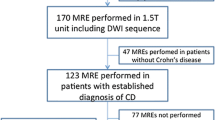Abstract
Every single imaging finding that can be disclosed on conventional and MR enteroclysis was correlated with the Crohn’s disease activity index (CDAI). Nineteen consecutive patients with Crohn’s disease underwent colon endoscopy and both conventional and MR enteroclysis examinations. Seventeen MR imaging findings and seven conventional enteroclysis findings were ranked on a four-point grading scale and correlated with CDAI, with a value of 150 considered as the threshold for disease activity. Six patients had active disease in the colon according to colon endoscopy. In the remaining 13 patients, the presence of deep ulcers (P=0.002), small bowel wall thickening (P=0.022) and gadolinium enhancement of mesenteric lymph nodes (P=0.014) identified on MR enteroclysis images were strongly correlated to disease activity. The product of deep ulcers and enhancement of lymph node ranks identified on MR enteroclysis were the optimum combination for discriminating active from non-active disease (F-test: 55.95, P<0.001). Additionally, the ranking of deep ulcers on conventional enteroclysis provided statistically significant differences between active and non-active patients (F-test: 14.12, P=0.004). Abnormalities strongly suggestive of active Crohn’s disease can be disclosed on MR enteroclysis examinations and may provide pictorial information for local inflammatory activity.






Similar content being viewed by others
References
Nolan DJ, Gourtsoyiannis NC (1980) Crohn’s disease of the small intestine: a review of the radiological appearances in 100 consecutive patients examined by a barium infusion technique. Clin Radiol 31:597–603
Cirillo LC, Camera L, Della Noce M, Castiglione F, Mazzacca G, Salvatore M (2000) Accuracy of enteroclysis in Crohn’s disease of the small bowel: a retrospective study. Eur Radiol 10:1894–1898
Gourtsoyiannis N, Papanikolaou N, Grammatikakis J, Maris T, Prassopoulos P (2000) Magnetic resonance imaging of the small bowel using a True-FISP sequence after enteroclysis with water solution. Invest Radiol 35:707–711
Gourtsoyiannis N, Papanikolaou N, Grammatikakis J, Prassopoulos P (2002) MR enteroclysis: technical considerations and clinical applications. Eur Radiol 12:2651–2658
Prassopoulos P, Papanikolaou N, Grammatikakis J, Rousomoustakaki M, Maris T, Gourtsoyiannis N (2001) MR enteroclysis imaging of Crohn’s disease. Radiographics 21(Spec no):S161–S172
Umschaden HW, Szolar D, Gasser J, Umschaden M, Haselbach H (2000) Small-bowel disease: comparison of MR enteroclysis images with conventional enteroclysis and surgical findings. Radiology 215:717–725
Faber SC, Stehling MK, Holzknecht N, Gauger J, Helmberger T, Reiser M (1997) Pathologic conditions in the small bowel: findings at fat-suppressed gadolinium-enhanced MR imaging with an optimized suspension of oral magnetic particles. Radiology 205:278–282
Low RN, Sebrechts CP, Politoske DA, Bennet MT, Flores S, Snyder RJ, Pressman JH (2002) Crohn disease with endoscopic correlation: single-shot fast spin echo and gadolinium enhanced fat suppressed spoiled gradient echo MR imaging. Radiology 222:652–660
Schmidt S, Lepori D, Meuwly JY, Duvoisin B, Meuli R, Michetti P, Felley C, Schnyder P, van Melle G, Denys A (2003) Prospective comparison of MR enteroclysis with multidetector spiral-CT enteroclysis: interobserver agreement and sensitivity by means of “sign-by-sign” correlation. Eur Radiol 13:1303–1311
Goldberg HI, Caruthers SB Jr, Nelson JA, Singleton JW (1979) Radiographic findings of the National Cooperative Crohn’s Disease Study. Gastroenterology 77(4 Pt 2):925–937
Kettritz U, Isaacs K, Warshauer DM, Semelka RC (1995) Crohn’s disease. Pilot study comparing MRI of the abdomen with clinical evaluation. J Clin Gastroenterol 21:249–253
Schunk K, Kern A, Oberholzer K, Kalden P, Mayer I, Orth T, Wanitschke R (2000) Hydro-MRI in Crohn’s disease. Appraisal of disease activity. Invest Radiol 35:431–437
Maccioni F, Viscido A, Broglia L, Marrollo M, Masciangelo R, Caprilli R, Rossi P (2000) Evaluation of Crohn disease activity with magnetic resonance imaging. Abdom Imaging 25:219–228
Koh DM, Miao Y, Chinn RJ, Amin Z, Seegen R, Westaby D, Healy JC (2001) MR imaging evaluation of the activity in Crohn’s disease. Am J Roentgenol 177:1325–1332
Madsen SM, Thomsen HS, Munkholm P, Davidsen B, Dorph S, Nielsen SL, Schlichting P (2002) Inflammatory bowel disease evaluated by low-field magnetic resonance imaging. Comparison with endoscopy, 99mTc-HMPAO leucocyte scintigraphy, conventional radiography and surgery. Scand J Gastroenterol 37:307–316
Yacyshyn BR, Chey WY, Goff J, Salzberg B, Baerg R, Buchman AL, Tami J, Yu R, Gibiansky E, Shanahan WR (2002) Double blind, placebo controlled trial of the remission inducing and steroid sparing properties of an ICAM-1 antisense oligodeoxynucleotide, alicaforsen (ISIS 2302), in active steroid dependent Crohn’s disease. Gut 51:30–36
Hanauer SB, Feagan BG, Lichtenstein GR, Mayer LF, Schreiber S, Colombel JF, Rachmilewitz D, Wolf DC, Olson A, Bao W, Rutgeerts P (2002) Maintenance infliximab for Crohn’s disease: the ACCENT I randomized trial. Lancet 359:1541–1549
Steinhart AH, Ewe K, Griffiths AM, Modigliani R, Thomsen OO (2001) Corticosteroids for maintaining remission of Crohn’s disease. Cochrane Database Syst Rev CD000301
Herlinger H, Furth EE, Rubesin SE (1998) Fibrofatty proliferation of the mesentery in Crohn disease. Abdom Imaging 23:446–448
Author information
Authors and Affiliations
Corresponding author
Rights and permissions
About this article
Cite this article
Gourtsoyiannis, N., Papanikolaou, N., Grammatikakis, J. et al. Assessment of Crohn’s disease activity in the small bowel with MR and conventional enteroclysis: preliminary results. Eur Radiol 14, 1017–1024 (2004). https://doi.org/10.1007/s00330-004-2302-8
Received:
Revised:
Accepted:
Published:
Issue Date:
DOI: https://doi.org/10.1007/s00330-004-2302-8




